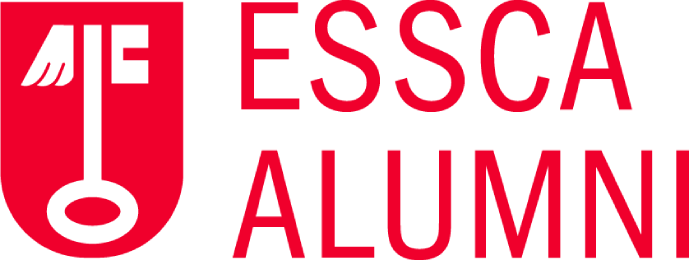L'Esprit des Lieux: Les Racines Angevines

ESSCA's first premises in Angers, rue Merlaye de la Boulaye
Dematerializationis all the rage.In the age of e-learning, video conferencing and the Internet, some are prophesying the death of establishedthe death of established structures and advocate the advent of widespread nomadism.
This is confusing the means with the end.
A school, like any living organism, needs roots. They define its bearings, its space and, ultimately, its identity. ESSCA is no exception to this rule. Today, the school is spread over a number of sites, but paradoxically Angers, its original birthplace, retains all its importance and continues to grow spectacularly.
It's this centuries-old history that we'd like to share with you today.
The Palais de l'Université Catholique de l'Ouest was built at the end of the Second Empire and completed in 1875 by diocesan architect René-Eugène DUSSOUCHAY on the grounds of the former nurseries of André
LEROY (1801-1875), donated by his son-in-law Edouard LORIOL DE BARNY, future and very short-lived mayor of Angers. The neo-classical Palais Universitaire was built thanks to subscriptions, donations and contributions from religious communities.
In 1909, the UCO offered our fledgling institution temporary shelter on the second floor of its Palais Académique, before it was moved to the Dominican Convent and then back to Place André Leroy. Spartan conditions if ever there was one, the University provided two amphitheatres and an office!
Here, for thirty years and as many graduating classes, the school offered its two-year curriculum and complementary courses.
With the outbreak of the Second World War looming, the Director, supported by the Alumni Association, had long since decided to construct a building where the School would be housed in its own home.
Good for him, because after the defeat, the Germans requisitioned and occupied a large part of "la Catho. "
And so, at the very end of 1939, students passed through the new porch crowned with the coat of arms of the Bishop of Angers. The school had its own premises, in a building located at the corner of Rue Rabelais and Rue Merlet-de-la-Boulaye, at number 8, on a plot of land within the UCO grounds, behind its park.
The building, which cost 800,000 old francs, is leased by the school to the Société Immobilière des Facultés Libres de l'Ouest, owners of the land. The annual rent is 20,000 francs, with the Établissement covering heating, lighting and service costs. The new school also benefits from a pleasant 500 m2 courtyard and garden. As for infrastructure, it boasts four classrooms, a library and two offices!
It's Byzantium for the 70 students, who are unaccustomed to so many conveniences, but whose numbers are rapidly swelling tos quickly swelled to 101, due to the exodus of 1940 and the "withdrawn classes", and even to 118 including the special classes!
The building underwent two extensions in 1953 and 1956, which doubled the surface area of the premises, due to the growth in enrolment and the change from two to three years of study.This was due to the increase in enrolment and the move from two to three years of study decided in 1952, and implemented on an optional basis from 1954 for students in the course of their studies.

Inauguration attended by Roselyne BACHELOT, General Councillor for Maine-et-Loire; Hubert GRIMAUD, Deputy for Maine-et-Loire; Jean SAUVAGE, President of the General Council for Maine-et-Loire; Olivier GUICHARD, President of the Pays de la Loire Regional Council and Jean MONNIER, Mayor of Angers.
In order to finance these improvements, worth around 26 million old francs, the ESSCA Alumni Association, under the aegis of the UCO, launched a 4% loan to its members. 400 bonds of 5,000 francs were issued for six years from January 1, 1954.
As it stood in 1969 when it was transferred, the school also featured a spacious entrance hall, a typing room and an additional office.
The first lease, signed in January 1940, ran until the end of 1964. At that time, the growth of the school and the fact that the town wanted to buy back part of the land in order to widen Rue Rabelais, made it imperative to move and rebuild on a new site. The premises were therefore sold to ESEO. In September 1966, a 2.92-hectare plot of pastureland at "La Forêt" in the commune of Beaucouzé was pre-empted. The land was part of the new university campus that the city of Angers was creating in Belle-Beille, and as such the École benefited from a very attractive price.
However, in order to complete the purchase and receive subsidies from the city and the département, which guaranteed part of the loans, it was necessary to create an Association with the legal status to enable the transaction. The law of 1875 authorized faculties to set up schools, but these had no legal personality. The law of 1901, on the other hand, allows the creation of non-profit associations with legal personality.
TheESSCA Association 's articles of association were filed on August 23, 1967 and registered in the French Official Journal on September 3. The Association is managed by the Université Catholique de l'Ouest, the Angers Chamber of Commerce, teachers, students and alumni.
At the end of July 1968, the building project on rue Lakanal was selected. The plans were drawn up by architect MORNET in collaboration with the outgoing COCARD-POURRIAS management team. The total cost of the project was 3.663 million francs, including 2.1 million in loans, which would weigh heavily on the school's budget in the years to come. All the more so as there is no question of raising the price of tuition. In fact, students were not entitled to state scholarships at the time, as the school had not yet been granted recognition status.
Construction was quickly completed and ESSCA moved into its new premises at the start of the 1969 academic year.
Jacques de LATROLLIERE, who finalized the project with the then new Director Jean LOTTE (1967/1974), gives us an accurate description: " Three thousand square meters on a single level, arranged around a convivial patio. A large lecture hall, three smaller ones and, adjoining them, some fifteen rooms for group work; not forgetting the library, a language laboratory, a typing room and, in the basement, a large gym; finally, a wing for the permanent staff and management. It's a harmonious whole, and from the outset we're very comfortable with less than 200 students, who can annex unused rooms for student activities. "
With this class of 71 students, the new four-year study cycle begins.These include IT, marketing and languages, as well as a first laboratory, while a larger part is devoted to internships, for which ESSCA is proving to be a pioneering institution. The aim of the fourth year is to enable students to develop their career plans in greater detail.
The school'sexpansion led to the construction of a new wing extending the boardroom in 1975.
As the École celebrates its 75th anniversary, it is faced with the challenge of meeting the ever-increasing demand that underpins its reputation, while maintaining the quality of its recruitment. The selectivity of the entrance exam, far from being a hindrance, is quite the opposite. The number of candidates rose from 212 in 1969 to 1,433 in 1982, 2,022 in 1983, 2,522 in 1984, 3,022 in 1985, 3,613 in 1986 and 3,862 in 1987. This very substantial increase justifies the gradual expansion of the graduating classes. But going from 110 to 150 students is not without consequences, and implies major adaptations in terms of human resources, equipment and premises.
In 1984, with the construction ofanother wing on the park side, two new classrooms and five new offices made it possible to meet the most pressing needs.
But the school's strategic direction required work on an entirely different scale. While the projects focus primarily on improving initial training, they also include other objectives, and not the least: specific training initiatives to serve companies, post-graduate and specialization courses, and an increase in the school's international exchanges.
Faced with a rapidly changing economic environment, the École has decided to give itself the means to fully meet the expectations of companies by optimizing the quality of its training. A broader framework, more in line with new ambitions, was required. In June 1987, Philippe CESBRON-LAVAU, Chairman of the Board of Directors, and Michel CASTE-BALLEREAU, Managing Director (1980/90), kicked off a 3,500 m2 building extension. The "Jean MONNET" building, the School's flagship, designed by the ROLLAND practice in Angers, was delivered in record time. Symbolic of the School's growth is the appearance of the elevator in the building. The inauguration, with lasers, holograms and music by Jean-Michel JARRE, took place on November 5, 1988, and left a lasting impression on the students present. The cost of extending the school totaled 26.1 million francs, 11 million of which were financed by the city of Angers, the Conseil Général and the Conseil Régional, and 30% by loans.
The number of students rose from 130 to 180, and from 530 in 1988 to 600 in 1989.

Laser show for the inauguration of the Jean Monet building in 1988

In its November 6, 2001 issue, Ouest-France reports on the inauguration of the new extension, attended by Jean-Claude ANTONINI, Mayor of Angers, François FILLON, President of the Pays de la Loire Regional Council, André LARDEUX, President of the Maine-et-Loire General Council and Jean-Pierre BERNHEIM, President of ESSCA.
The strengthening of the Group's national and international structure in the first half of the 90s, with the creation of the Paris site and theHungarian establishment, not to mentionESIAME-Cholet, did nothing to slow down the growth of the Anjou campus - quite the contrary. On October 21, 1992, Sébastien FLUTE, Olympic archery gold medallist in Barcelona, honoured the inaugural festivities for the new reception area and grounds with his presence.
The adoption of the new five-year curriculum at the start of the 1998 academic year, and the innovative nature of its architecture in the French business school landscape, precipitated triple recognition: from students, who voted for the school en masse; from recruiters, for whom ESSCA became the benchmark; and from labels, which recognized the excellence of the programs and the work accomplished. ESSCA has established itself as the leading five-year post-baccalaureate business school. In implicit recognition of this success, the school's formula is now being copied...
In view of the ever-increasing number of students and the associated quality imperatives, it was once again essential to expand the school's infrastructure. Anew 2,500 m2building was added to the Anjou site in 2001.
Today, almost 5,200 high school graduates attempt the ESSCA entrance exam, with 420 places available, divided equally between the Group's two sites in Anjou and Paris (see "Paris"). "210 students enter their first year at Belle-Beille. As for the Parisians, they must complete their third year in Angers. With 2,400 students and corporate auditors on campus, the school's capacity once again reached its limits.
So, in September 2009, the school underwent a remarkable expansion. A total of 4,400 m2 of new space was made available to students and staff alike. A building complying with High Environmental Quality standards houses 21 classrooms, including eight lecture theaters, 40 offices and reception areas, each equipped with the most appropriate high tech equipment. Once again, the building was designed by Angevin architect Frédéric ROLLAND. The site has been extended by around a quarter to over 17,000 m2. The 9 million euro cost of the works is largely borne by the School's institutional partners, with the City, Department and Region each contributing 2.2 million euros, for a total of 6.6 million.

The new extension, inaugurated in September 2009, has 19 classrooms and lecture theaters.



